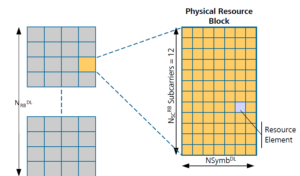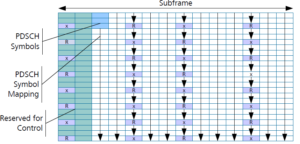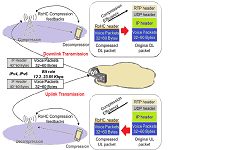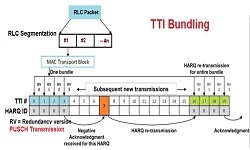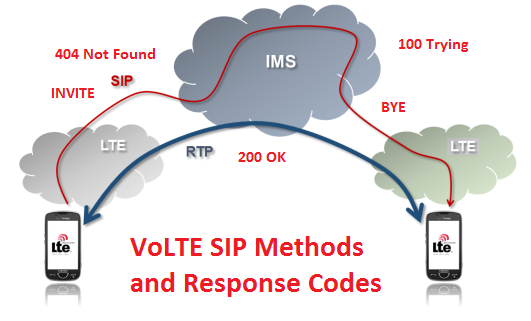VoLTE Cell Capacity- Calculating Packet Size, PRBs and No. of Users
The mobile operators are or have moved to voice over LTE (VoLTE). Globally, voice is still the major chunk of ARPU for the telecommunications industry. However, basic voice may not be enough to remain relevant in an LTE environment which is data services by default, because subscriber communication is shifting from plain voice to HD voice.
Many VoLTE networks are live and are providing excellent high definition (HD) voice services to user. Actually, in real life, the subscribers probably doesn’t care about VoLTE. All they want is good quality HD voice calls to complement their high-speed wireless data services. VoLTE is positioned to deliver the goods, but how is it compared with other wireless voice solutions such as 2G/3G CS calls?
To find out , it required following simple calculations:
- VoLTE Call Packet Size Calculation
- Radio Resource Calculation for VoLTE packet
- No. of Max. Theoretical VoLTE user per cell
VoLTE Call Packet Size Calculation
VoLTE call packet is size is not fix, it depends on codec used by for voice, UE radio conditions in the cell, eNodeB’s scheduling algorithm, the protocol used , and so on. To avoid these many variable and complex calculation, let’s find out one particular aspect of VoLTE capacity i.e. how many Physical Resource Blocks (PRBs) are required for one VoLTE call over the air interface?
To start with, let’s take following assumptions
- LTE System bandwidth: 20 MHz (100 PRB)
- Dulpex Mode: FDD
- MIMO Mode: 2×2
- Codec: Adaptive Multi Rate -Wide Band Codec (AMR-12.65)
- RoHC enabled
An AMR-WB 12.65 coder generates about 253 bits of coded speech every 20 ms. In order to deliver each voice sample to the UE needs to add protocol headers such as RTP header (typically 12 bytes), a UDP header (8 bytes), and an IP header (40 bytes).
VoLTE Packet length with all Header= Codec Bits + RTP Header + UDP Header + IP Header
= 253 Bits+ 12*8(=96 Bits) +8*8(=64 Bits) + 40*8(=320 Bits)
This results in the total packet length up to some 733 bits every 20 ms.
When RoHC is enabled, it will replace the RTP, UDP and IP headers with a much smaller RoHC header before the packet is actually transmitted over the air. The length of the RoHC header will vary depending on the particular circumstances, but on an average it will be around 3 bytes, or 24 bits. The RLC and MAC layers will add their own overheads, hence only about 300 bits are needed for every VoLTE voice call packet at the air interface.
Radio Resource Calculation for VoLTE Packet
The above calculation states that about 300 bits are required for VoLTE voice packets. Then how many Radio resources are required to be transmitted over the air. In LTE the unit of radio resource is known as Physical Resource Block (RB) and one PRB has 12 sub carrier and 14 symbols (Normal Cyclic Prefix) over 1 mili second time duration, or 12*14=168 Resource Elements (REs).
Some of REs are occupied by the control symbols (PDCCH) and Pilot symbols (RS), which provides about 120 REs available for Data transmission.
LTE downlink modulation supports QPSK, 16 QAM and 64 QAM for PDSCH which means each Resource can carry 2Bits, 4 Bits or 6 Bits based on modulation scheme used. But some of these bits will be used for data and some for error control bits (modulation and coding rate shown in figure below). So number of Resource blocks required for VoLTE packets depend on what modulation is applied and modulation depends on the radio condition of the UE. UE reports RF conditions with Channel Quality Indicator (CQI) to eNodeB and using this report eNodeB decide the modulation for particular resource block. The CQI report range is 0-15 where 15 is the best channel condition. 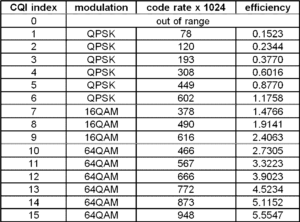
Let’s consider CQI 15 =Good , CQI 7 = Average and CQI 1 = Poor and CQI 15 provides 64 QAM, CQI 7 provides 16 QAM and CQI 1 results QPSK modulation.
- When UE reports CQI 15 then eNodeB can use 64QAM modulation and a 948/1024 = 0.926 effective coding rate is applied, which means that each RE holds 6 x 0.926 = 5.55 data bits on average. Considering this a single PRB can then carry 120 x 5.55 = 666 data bits, or the equivalent of two VoLTE voice samples. But LTE scheduler can’t allocate less than one PRB per user, so this will count that one PRB is needed per VoLTE call.
- While UE reports CQI 7, then eNodeB can use 16QAM modulation and a 378/1024 = 0.369 coding rate, resulting in 4 x 0.369 x 120 = 177 data bits. This means for 300 bits VoLTE data requires two PRBs
- With CQI 1 report eNodeB can use QPSK modulation and a 78/1024 = 0.076 coding rate, supporting 2 x 0.076 x 120 = 18 data bits per PRB. So to transmit 300 bits VoLTE data it about 16 PRBs.
Numbers of Max. Theoretical VoLTE user Per Cell
In VoLTE voice data is generated every 20 mili second, so if everything is good i.e. there is no re-transmission, then about 20 VoLTE call can share the same set of PRB one after other.
The maximum number of VoLTE call that can be carried is then determined by:
- (Number of Available PRB)/ Number of PRB per VoLTE call) X 20
Hence VoLTE call per CQI and Bandwidth
| Channel Bandwidth | 1.4 MHz | 3 MHz | 5 MHz | 10 MHz | 15 MHz | 20 MHz |
|---|---|---|---|---|---|---|
| No. of Resource Block | 6 | 10 | 25 | 50 | 75 | 100 |
| CQI =15 (1 PRB) no. VoLTE User | 120 | 200 | 500 | 1000 | 1500 | 2000 |
| CQI =7 (2 PRB) no. VoLTE User | 60 | 100 | 250 | 500 | 750 | 1000 |
| CQI =1 (16 PRB) no. VoLTE User | 8 | 13 | 31 | 63 | 94 | 125 |
We might be surprised to knowing these high numbers and might have questions in mind that how realistic these numbers are? These number are for ideal condition with many presumptions , most of these assumption wouldn’t be true out in practice.
- All users in a cell would not report exactly the same CQI value, and a cell where every UE reports CQI value 1 is basically unusable.
- VoLTE packet arrivals would not be perfectly distributed across the 20 ms coding intervals.
- Most packets would require at least one HARQ re-transmission, especially at lower CQI values, which consumes additional PRBs.
- No operator wish to reserve all PRBs for VoLTE, some PRBs needs to be reserved for non-VoLTE (data) user hence this shall reduce the numbers of VoLTE per cell significantly .
- The uplink has a lower capacity than the downlink, in terms of the number of PRBs available (PRB need to be reserved for PRACH,PUCHH) and the efficiency of the transmissions.
- In TDD duplexing mode the no. of VoLTE user directly depends on the TDD configuration.
The above exercise provides some insight to what we can expect to see VoLTE in the field. Under good RF conditions, LTE can deliver VoLTE packets quickly and efficiently with less number of PRBs, with enough PRBs left over for other users. Under poor conditions, LTE will struggle to support even a few of users. Along with the RF condition the user capacity also depends on the bandwidth availability. When an operator have 20 MHz bandwidth certainly it serve large no. user even in the poor RF condition because availability of more PRBs.
The reality is that VoLTE has a voice call capacity comparable to legacy wireless voice solutions, like UMTS and CDMA2000 1x, on the order of 400 to 600 users per cell with 20 MHz. The challenge for the operators is to manage the end-to-end voice quality, and to juggle the conflicting demands of voice and data users to decide whether they need to reserved more resource block for Data or Voice.
Related Posts:
- VoLTE Cell Capacity- Calculating Packet Size, PRBs and No. of Users
- Voice Codec Options for VoLTE Services
- VoLTE SIP Methods, Response Codes and Details
- TTI Bundling for better HARQ and Latency
- Robust Header Compression – ROHC

